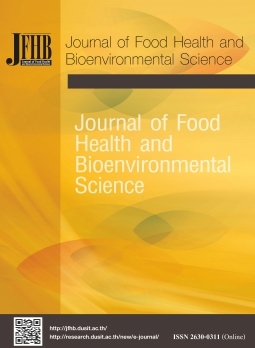Free Radical Scavenging Activity of Riceberry and Pathum Thani Rice Extracts for Developing Face Powder
Keywords:
Free radical scavenging activity, Color, Sun protection factor, Face powderAbstract
Thai rice today is not limited to staple food, but it has been transformed into a variety of medicinal and beauty products, as part of a growing industry with a bright future. We measured total phenolic content, total flavonoid content, free radical scavenging activity, lycopene, β-carotene, color and SPF of raw materials in face powder. Riceberry extract sample contained phenolic and flavonoid with the highest level at 26.46±0.008 mg GAE/g of extract and 101.63±0.034 mg Rutin/g of extract. Free radical scavenging activity was measured by DPPH assay: the Riceberry extract sample contained antioxidants that indicated the EC50 at 108.31±0.024 μg/mL. All raw materials showed SPF, which could be used as foundation data for making face powder. However, wood apple powder has the highest SPF for a material, that can be used as a raw material, for further development of face powder.
References
Ali, G., & Neda, G. (2011). Flavonoids and phenolic acids: Role and biochemical activity in plants and human. Journal of Medicinal Plants Research, 5(31), 6697-6703.
Anitha, T. (2012). Medicinal plants used in skin protection. Asian Journal of Pharmaceutical and Clinical Research, 5(3), 35-38.
Aust, O., Wilhelm, S., Helmut, S., Hagen, T., & Dan, U.H. (2003). Supplementation with tomato based products increase lycopene, phytofluene, and phytoene levels in human serum and protects against UV-light-induced erythema. International Journal for Vitamin and Nutrition Research, 75(1), 54-60.
Butsat, S., & Siriamornpun, S. (2010). Antioxidant capacities and phenolic compound of the husk, bran and endosperm of Thai rice. Food Chemistry, 119, 606-613.
Chakuton, K., Puangpronpitag, D., & Nakornriab, M. (2012). Phytochemical content and antioxidant activity of colored and non-colored Thai rice cultivars. Asian Journal of Plant Sciences, 11(6), 283-293.
Chen, X.Q., Nagao, N., Itani, T., & Irifune, K. (2012). Antioxidative analysis, and identification and quantification of anthocyanin pigments in different coloured rice. Food Chemistry, 135, 2783-2788.
Costache, M.A., Campeanu, G., & Neata, G. (2012). Studies concerning the extraction of chlorophyll and total carotenoids from vegetables. Romanian Biotechnological Letters, 17(5), 7702-7708.
Dhir, R., Harkess, R.L., & Bi, G. (2013). Physiological responses of ivy geranium beach and butterfly to heat stress. Journal of the American Society for Horticultural Science, 138(5), 344-349.
Dutra, E.A., Oliveira, D.A.G.C., Kedor-Hackmann, E.R.M., & Santoro, M.I.R.M. (2004). Determination of sun protection factor (SPF) of sunscreens by ultraviolet spectrophotometry. Brazilian Journal of Pharmaceutical Sciences, 40(3), 381-385.
Fazekas, Z., Gao, D., Saladi, R.N., Lu, Y., Lebwohl, M., & Wei, H. (2003). Protective effects of lycopene against ultraviolet B-induced photodamage. Nutrition and Cancer, 47, 181-187.
Flachenecker, P. (2012). Autoimmune diseases and rehabilitation. Autoimmunity Reviews, 11, 219-225.
Freddie, B., Jacques, F., Isabelle, S., Rebecca, L.S., Lindsey, A.T., & Ahmedin, J. (2018). Global cancer statistics 2018: GLOBOCAN estimates of incidence and mortality worldwide for 36 cancers in 185 countries. CA Cancer Journal Clin, 68(6), 394-424.
Jia, D., Fan, L., Liu, G., Shen, J., Liu, C., & Yuan, Y. (2011). Effects of genotypes and bagging practice on content of ß-carotene in apple fruits. Journal of Agricultural Science, 3(4), 196-202.
Khanthapok, P., & Sukrong, S. (2019). Anti-aging and health benefits from Thai food: Protective effects of bioactive compounds on the free radical theory of aging. Journal of Food Health and Bioenvironmental Science, 12(1), 54-67.
Leardkamolkarn, V., Thongthep, W., Suttiarporn, P., Kongkachuichai, R., Wongpornchai, S., & Wanavijitr, A. (2011). Chemopreventive properties of the bran extracted from a newly-developed Thai rice: The riceberry. Food Chemistry, 125(3), 978-985.
Lobo, V., Patil, A., Phatak, A., & Chandra, N. (2010). Free radicals, antioxidants and functional foods: Impact on human health. Pharmacognosy Review, 4(8), 118-126.
Mansur, J.S., Breder, M.N.R., Mansur, M.C.A., & Azulay, R.D. (1986). Determinacao do factor de protecao solar por espectrofotometria. Anais Brasileiros de Dermatologia, 61, 121-124.
Mir, S.A., Bosco, S.J.D., & Sunooj, K.V. (2013). Evaluation of physical properties of rice cultivars grown in the temperate region of India. International Food Research Journal, 20(4), 1521-1527.
Moko, E.M., Purnomo, H., Kusnadi, J., & Ijong, F.G. (2014). Phytochemical content and antioxidant properties of colored and non colored varieties of rice bran from Minahasa, North Sulawesi, Indonesia. International Food Research Journal, 21(3), 1053-1059.
Moeiklang, N., & Ruangviriyachai, C. (2014). Determination of phenolic compounds and antioxidant potential in fruit beverages. KKU Research Journal, 14(4), 69-79.
Nagata, M., & Yamashita, I. (1992). Simple method for simultaneous determination of chlorophyll and carotenoids in tomato fruit. Journal of the Japanese Society for Food Science Technology, 39, 925-928.
Ningjian, L., & David, D.K. (2014). Antioxidant property of coffee components: Assessment of methods that define mechanisms of action. Molecules, 19, 19180-19208.
Prabnok, J., Phasuk, S., & Takolpuckdee, P. (2016). Chemical compounds and antioxidation efficiency of Livistona speciosa Kurz. Seed crude extract. Thai Journal of Pharmaceutical Sciences, 40(Supplement Issue), 112-115.
Pukumpuang, W., & Seansrimon, J. (2020). Antioxidant activity, total phenolic content and anti-tyrosinase activity of Thai colored rice cultivar extracts. Journal of Food Health and Bioenvironmental Science, 13(1), 34-42.
Sadighara, P., Saghafi, M., Erfanmanesh, A., & Mahdaviyekta, M. (2016). Antioxidant activity and properties of outer shell pistachios in different temperature of cooking. Der Pharmacia Lettre, 8(12), 263-266.
Sreethong, T., Prom-u-thai, Ch., Rerkasem, B., Dell, B., & Jamjod, S. (2018). Variation of milling and grain physical quality of dry season Pathum Thani 1 in Thailand. Chiang Mai University Journal of Natural Sciences, 17(3), 191-202.
Stahl, W., & Sies, H. (2012). Photoprotection by dietary carotenoids: Concept, mechanisms, evidence and future development. Molecular Nutrition & Food Research, 56, 287-295.
Suttiarporn, P., Sookwong, P., & Mahatheeranont, S. (2016). Fractionation and identification of antioxidant compounds from bran of Thai black rice cv riceberry. International Journal of Chemical Engineering and Applications, 7(2), 109-114.
Ulrike, P.K., Dan, L., Marisa, O., Karl, S., & Thomas, M.R. (2006). Short and long wave UV light (UVB and UVA) induce similar mutations in human skin cells. Journal of Investigative Dermatology, 126(3), 667-675.
Downloads
Published
How to Cite
Issue
Section
License

This work is licensed under a Creative Commons Attribution-NonCommercial-NoDerivatives 4.0 International License.








